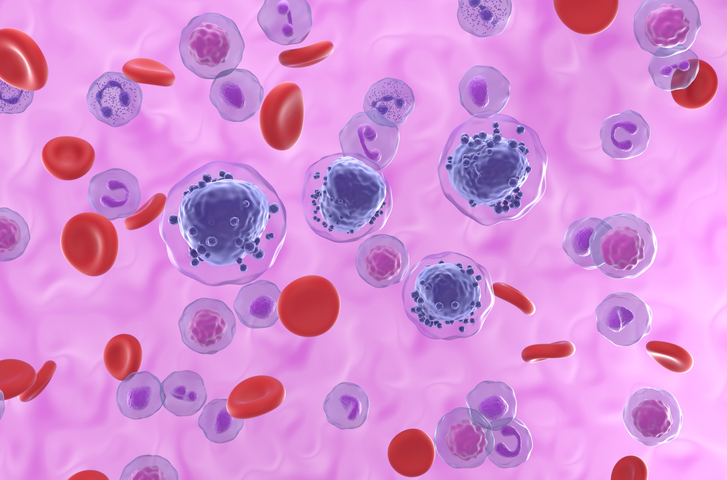Your cart is currently empty!

Few know the signs of parasite infection showing up in blood work. But, your routine CBC test may point to a parasitic worm infection…even if that parasitic worm is in your intestines, and not in your blood.
What you should know about parasites and a complete blood count test:
- Elevated eosinophils are present about 10% of the time when someone has a parasite infection, according to a study of 600 people with known parasite infections.
- Basophils may also be elevated when a parasitic infection is present.
- Low hemoglobin and anemia may be caused by parasitic worm infections.
- A CBC test is not definitive proof of a parasitic infection. Further parasite testing will be needed to prove or disprove if a parasite infection is present.
What does a CBC look like and what parts of it are important to look at? Here’s an example:
Parts of a CBC Most Likely To Indicate Parasite Infections
The parts of the test most significant for parasites are the eosinophil and basophil counts. It should be noted that not all parasites will elevate these values. Ascaris, hookworm, Strongyloides, Schistosoma, and Trichuris worms are the most likely to cause this problem.
EOS: The abbreviation stands for “eosinophils.” These white blood cells participate in the allergic response but also contain specific properties that make them effective against intestinal parasites. High levels of eosinophils could mean you have a parasitic infection, although severe allergies can also cause this elevation.
Baso: The term stands for “basophils.” It is a type of white blood cell found in very small numbers in the bloodstream. They play a role in circulation, prevention of blood clotting, allergies, and fighting parasites. These may also be elevated in a parasitic infection.
HGB: This is the hemoglobin and measures the amount of the oxygen-carrying protein in the bloodstream. Hemoglobin is found inside RBCs so the hemoglobin and RBC count often trend in the same direction. If you’re anemic, this level will be low. Worms can interfere with iron absorption or cause low-level bleeding that could lead to low HGB levels.
While these are good indicators, they do not prove or disprove much. Only 10 percent of people with known parasite infections had elevated eosinophils in one study of more than 600 people. This means that you still may have parasites even if the CBC is normal. On the other hand, an elevated EOS with parasite symptoms should prompt you to undergo a stool test for parasites to be sure.

Parts of a Complete Blood Count Test That Are Less Likely To Indicate Parasite Infections
These parts of the CBC test have could have some relationship with a parasite infection. But the links to parasite infections are weaker or less specific to parasites than the eosinophils and basophils parts of the CBC test.
RBC: This stands for red blood cells or “red blood cell count.” It is a measure of the total red blood cell count. If you are anemic, your RBC will be low. Anemia could be related to a parasitic worm infection, but other causes should be strongly considered as well.
WBC: This is the total white blood count. All of the white blood cells play some role in infections, so an elevation may mean you have an infection. Extremely high levels (above 50,000) often mean leukemia. A low WBC count may also mean you have an infection.
Mono: The abbreviation stands for “monocyte.” Certain infections will demonstrate elevated monocyte count. Any elevation usually means you are fighting some type of infection.
Lymph or LY: The lymphocytes are specific small round cells that often produce antibodies against infection. High levels often mean a viral infection.
PMN or Seg: This is the polymorphonuclear leukocyte (PMN) count. The abbreviation “Seg” means segmented, which shows up in the appearance of the nucleus in one of these cells. These are direct infection-fighting cells.
PLT: This is your total platelet count. Your platelets contribute to blood clotting. High and low platelet levels often indicate a bone marrow problem or reaction in the immune system. Low levels can put you at risk for bleeding.
Actual Tapeworm Infection Diagnosed By Our Testing Had Anemia and High Eosinophils
In early 2024, we had a patient who tested positive for a heavy tapeworm infection via our stool test. This person listed both anemia and high eosinophils on their intake form. So while their CBC test couldn’t prove that they had a tapeworm infection, it did correlate with anemia + high white blood cells count.
Conclusion
Parasites in your intestinal tract can be sneaky. You can have them for weeks, months, or years and not get an accurate diagnosis because your symptoms were vague or your doctor didn’t think to test for them. Armed with this new knowledge about parasites being potentially indicated by routine bloodwork, you may be able to justify parasite testing.
Frequently Asked Questions
Can You Detect Parasites In a Routine Blood Test?
Routine blood work like a complete blood count test can’t prove or disprove that you have a parasite…but it can help justify parasite testing. There is stool testing, as well as many blood parasite tests that help detect parasite tests.
Do Parasites Cause High White Blood Cell Count?
Worm parasite infections have been linked to elevated eosinophils white blood cells and elevated basophils white blood cells. But just because someone has elevated white blood cells, it does not prove they have a parasite infection. There are multiple non-parasitic causes of elevated while blood cells. Further testing, like an O&P stool test, is needed to prove or disprove a parasite infection.
References:
Khanna, V., Tilak, K., Mukhopadhyay, C., & Khanna, R. (2015). Significance of Diagnosing Parasitic Infestation in Evaluation of Unexplained Eosinophilia. Journal of clinical and diagnostic research : JCDR, 9(7), DC22–DC24.
Movahed, R., Khara, H., Ahmadnezhad, M., & Sayadboorani, M. (2016). Hematological characteristics associated with parasitism in Pikeperch Sander lucioperca (Percidae) from Anzali Wetland. Journal of parasitic diseases : official organ of the Indian Society for Parasitology, 40(4), 1337–1341.